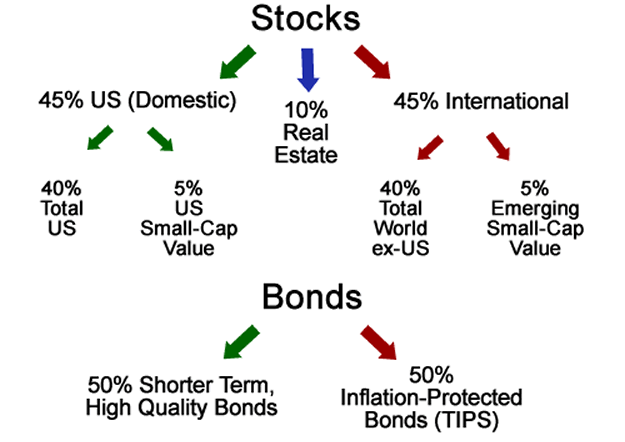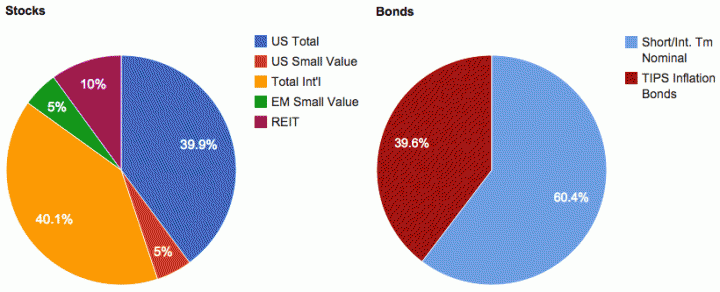Here’s an update on my investment portfolio holdings for Q3 2014. This includes tax-deferred accounts like 401(k)s and taxable brokerage holdings, but excludes things like physical property and cash reserves (emergency fund). The purpose of this portfolio is to create enough income to cover all of our household expenses.
Target Asset Allocation

I try to pick asset classes that will provide long-term returns above inflation, regular income via dividends and interest, and finally offer some historical tendencies to balance each other out. I don’t hold commodities futures or gold as they don’t provide any income and I don’t believe they’ll outpace inflation significantly. In addition, I am not confident in them enough to know that I will hold them through an extended period of underperformance (don’t buy what you don’t understand).
Our current ratio is about 70% stocks and 30% bonds within our investment strategy of buy, hold, and rebalance. With a self-directed portfolio of low-cost index funds and low turnover, we minimize management fees, commissions, and taxes.
Actual Asset Allocation and Holdings
Stock Holdings
Vanguard Total Stock Market Fund (VTI, VTSMX, VTSAX)
Vanguard Total International Stock Market Fund (VXUS, VGTSX, VTIAX)
WisdomTree SmallCap Dividend ETF (DES)
WisdomTree Emerging Markets SmallCap Dividend ETF (DGS)
Vanguard REIT Index Fund (VNQ, VGSIX, VGSLX)
Bond Holdings
Vanguard Limited-Term Tax-Exempt Fund (VMLTX, VMLUX)
Vanguard Intermediate-Term Tax-Exempt Fund (VWITX, VWIUX)
Vanguard High-Yield Tax-Exempt Fund (VWAHX, VWALX)
Vanguard Inflation-Protected Securities Fund (VIPSX, VAIPX)
iShares Barclays TIPS Bond ETF (TIP)
Individual TIPS securities
U.S. Savings Bonds (Series I)
Notable Changes
Last quarter, I had sold my PIMCO Total Return fund holdings. Well, that was lucky on my part with all the recent Bill Gross drama. I decided to sell my stable value fund holdings too as I needed rebalance into more TIPS bonds and I was now able to buy TIPS inside my employee retirement plan using the Schwab PCRA brokerage window. All of our tax-deferred space is now taken up with TIPS and REITs, so the rest of my bonds are tax-exempt munis and savings bonds.
Otherwise, not much new, I rebalanced with new money and reinvested dividends. By this, I mean I don’t automatically reinvest dividends into the same mutual fund or ETF that generated them. Instead, they accumulate for bit and then I reinvest them in whatever asset class has been lagging recently. This also makes fewer tax lots for my taxable accounts.
That’s it for portfolio holdings. In a separate update post, I will update the amount of income that I am deriving from this portfolio.

 The Best Credit Card Bonus Offers – 2025
The Best Credit Card Bonus Offers – 2025 Big List of Free Stocks from Brokerage Apps
Big List of Free Stocks from Brokerage Apps Best Interest Rates on Cash - 2025
Best Interest Rates on Cash - 2025 Free Credit Scores x 3 + Free Credit Monitoring
Free Credit Scores x 3 + Free Credit Monitoring Best No Fee 0% APR Balance Transfer Offers
Best No Fee 0% APR Balance Transfer Offers Little-Known Cellular Data Plans That Can Save Big Money
Little-Known Cellular Data Plans That Can Save Big Money How To Haggle Your Cable or Direct TV Bill
How To Haggle Your Cable or Direct TV Bill Big List of Free Consumer Data Reports (Credit, Rent, Work)
Big List of Free Consumer Data Reports (Credit, Rent, Work)
Why do you hold the same amount of domestic and international stock? Vanguard’s own target date funds seem to allocate stocks at 70% domestic and 30% international.
Travis
It is my understanding that 70/30 is common because it is historically the efficient frontier for the last 50 years. I personally believe the future efficient frontier will be different than the historical frontier, although nobody can really know what that will be.
Thus, I keep my allocation close to the world’s float-adjusted market-cap weighting, which is very close to 50% US and 50% World except US. Similar to the Vanguard Total World ETF:
https://personal.vanguard.com/us/funds/snapshot?FundId=3141&FundIntExt=INT
Jonathan, not sure if you had a look at the TFB article on rebalancing http://thefinancebuff.com/rebalancing-sell-high-buy-higher.html
What are your thoughts since this was also in the Boogleheads forum?
Seems like a reasonable enough article to me. Rebalancing is most importantly about managing risk and I also see it as preventing performance chasing.
Big picture-wise, if you started with say 80% stocks and 20% bonds and never rebalanced, you’d eventually be like 99% stocks and 1% bonds given how stocks have significantly higher historical returns. In that way, rebalancing actually lowers your expected returns.
Also with TIPS hardly yielding anything is there a reason to have it in tax deferred?
TIPS are yielding little now, but who knows what the yield environment will be in 5 or 10 years. Switching back will have its own set of tax consequences. I’d rather just pay the lower tax rate on my dividends for now and not worry about currently what interest rates and/or inflation rates will be.
Jonathan, question for you, in your portfolio, you didn’t include your house as part of your “investment” or “asset”. But in reality, since you paid it off, you essentially have a huge pile of cash that is sit in your house. If you look at your total asset as a whole, your house will probably be as much as 30-40% of your portfolio. So when you reviewing your retirement plan, you do not consider the equity in your house?
I view my paid-off house as simply a reduction of future housing expenses. I still need a portfolio to create income for other expenses, and I view a 60/40 portfolio as a reasonable long-term way to create that income stream via dividends and interest.
Curious if you’ve ever considered retiring in a place with a lower cost of living…
I’ve considered it, but it all comes down to your own personal priorities. I happen to like living near family with multiple generations living close to each other. Other people will think that sounds horrible. I could certainly be retired today if I was willing to move to Thailand or Mexico, and that works for a lot of folks.
Jonathan,
I am just getting my feet wet in bonds, looking at Vanguard and Fidelity. Is there any reading resource for someone who is just starting out? Imagine, I have absolutely no idea what this is and I want to learn. Most resource I read online are not for starters. Will appreciate any pointers. Thanks in advance.